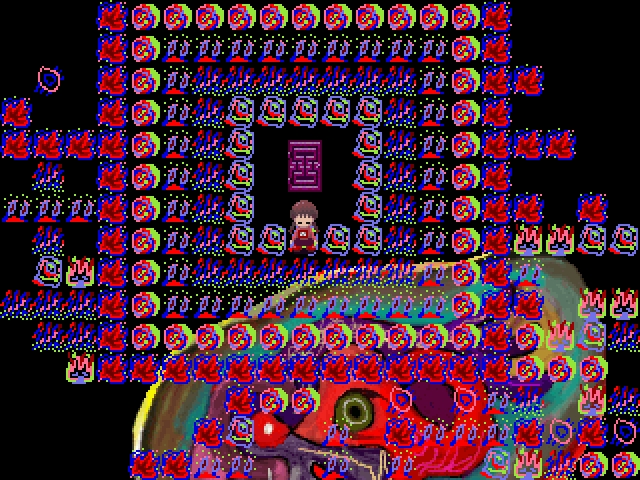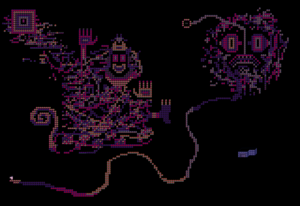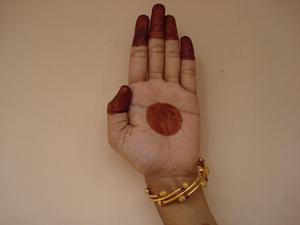Graffiti World(Hopi mythology)
※Graffiti World Map of "Red", "Yellow", "Purple", and a "White(Green?)" color
It is the same as the color of "the book of a Madotsuki's Room's bookshelf".
※Neon World Door's color is "Red","Yellow","Green" light and "Purple" door. http://yumenikki.wikia.com/wiki/Neon_World(name)#Neon_World.28Hopi_mythology.29
Graffiti World(LSD (video game))
| LSD | |
|---|---|
| [1] | |
| Developer(s) | OutSide Directors Company |
| Publisher(s) | Asmik Ace Entertainment |
| Platform(s) | PlayStation, PSN |
| Release date(s) | |
| Genre(s) | Miscellaneous, horror |
| Mode(s) | Single player |
| Media/distribution | CD-ROM |
2007年03月25日 22:16
"奇ゲー紀行1:Playstation用ソフト「LSD」1/10" #9:00~9:48
Movie by "Microglobe" http://www.nicovideo.jp/watch/sm69897
アップロード日: 2008/04/22
"Yume Nikki - How to get the Bicycle" #0:25~0:55
Movie by "ToraMaikeru" http://www.youtube.com/watch?v=juT3k8nVYEY
2007年03月25日 22:16
"奇ゲー紀行1:Playstation用ソフト「LSD」2/10" #0:00~1:00
Movie by "Microglobe" http://www.nicovideo.jp/watch/sm69962
Graffiti World(List of mudras)
One of the most striking features of Indian classical dance is the use of hand gestures.
Actually speaking in order to convey meaning and expressions, hand gestures make a prominent existence. However hand gestures known as nritta hastas are employed for the sake of beauty and decorative purposes while performing nritta.
This is a list of mudras.
Graffiti World(Mudra)
A mudrā (English: /muːˈdrɑː/ ([2] listen); Sanskrit: मुद्रा "seal", "mark", or "gesture"; Tibetan. ཕྱག་རྒྱ་, chakgya) is a symbolic or ritual gesture in Hinduism and Buddhism.[1] While some mudrās involve the entire body, most are performed with the hands and fingers.[2] A mudrā is a spiritual gesture and an energetic seal of authenticity employed in the iconography and spiritual practice of Indian religions and traditions of Dharma and Taoism.
The Chinese translation is yin (Chinese: 印; pinyin: yìn) or yinxiang (Chinese: 印相; pinyin: yìnxiàng). The Japanese and Korean pronunciation is "in".
Graffiti World(印相)
サンスクリット語ムドラー(मुद्रा [mudraa])の漢訳であり、本来は「封印」「印章」などを意味する。主に仏像が両手で示す象徴的なジェスチャーのことを指す。
- 施無畏印(せむいいん)
- 手を上げて手の平を前に向けた印相。漢字の示す意味通り「恐れなくてよい」と相手を励ますサインである。不空成就如来が結ぶ。
1 Outline
Sanskrit mudra (मुद्रा [mudraa])
It is translation into Chinese of [mudraa] and, originally means a "seal", a "mark", etc.
A Buddha statue mainly points out the symbolic gesture shown with both hands.
2 Main Seals
The seal which raised the granting-freedom-from-fear (せむいいん) hand, and was turned with the palm near at hand.
It is a sign which encourages a partner not to be "afraid" as the meaning which a Chinese character shows.
Non-empty accomplishment Buddha(不空成就如来) connects.
※Graffiti World Map is "kind of Buddha(不空成就如来)" from "A Buddha statue mainly points out the symbolic gesture shown with both hands. "




